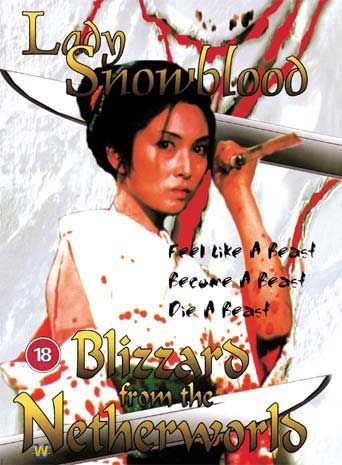Lady Snowblood: Blizzard from the Netherworld

Title: Lady Snowblood: Blizzard from the Netherworld
Rating: 4/5
Genre: Action, Drama, Thriller
Starring: Meiko Kaji, Toshio Kurosawa
Director: Toshiya Fujita
Language: Japanese
Concluding my stint on 70s cinema comes a pair of films that are perhaps most aptly described as the ‘original’ version to Tarantino’s ‘Kill Bill;’ his borrowing from this era of film making is a fact he’s more than open about and indeed opened the gateway for my own exploration. Filled with more sword-wielding carnage through its tale of retribution, Meiko Kaji (the star of the ‘Female Prisoner’ series) makes another return as a wholly different, yet equally mesmerising character.
Set in 1874 Japan, the tale follows Yuki – aka Lady Snowblood – (Kaji), a woman bore in prison to a woman incapable of exacting her revenge on the three responsible for brutally murdering her husband and raping her. Dying during labour, her child is raised according to her wishes, her sole purpose to exact bloody vengeance for the sadistic actions of such men. Based on the manga of the same name (written by the man who gave us ‘Lone Wolf and Cub’ no less), you can be assured that no expense is to be spared in the loss of life, limbs and gratuitous floods of blood in this tale of vigilante justice.
Despite the remarkably similar sounding premise, the aspect most intriguing here is lost in Tarantino’s work; the character of ‘Lady Snowblood’ is not a generic two-dimensional assassin and the strongest aspect is indeed the drama pertaining to the challenge she is to face. Is she to follow her mother’s wishes? Or will she follow her perceived destiny? And furthermore, what is to become of her if she succeeds? There is a subtle dark realism she brings to the character that elevates this from another mere gratuitously bloodthirsty film. With a lesser focus on the minor characters, notably the nonetheless capable journalist who becomes entangled in her web of anarchy (Kurosawa), this proves to be an expert marriage of director and actors, working with one another to produce a clarity of character vision.
One of the most striking aspects to its direction is the imagery used, the juxtaposition of beauty and death running rampant throughout the film, ushering in this young woman dressed entirely in white as the saviour of the story; not least in the blood soaked protagonist walking through the snow, or the blood-red snow fall during the powerful scene of the new life in Yuki crying next to her dying mother. The effects are simplistic but effective in the manner they are used, the use of colour evidently with significant thought as it creates the desired atmosphere.
This proves to be another worthy addition to the notion of combining ‘art-house with grind-house,’ though the manner it comes across is vastly different to that in ‘Female Prisoner.’ This is a cliché tale of vengeance wrapped up in numerous sub plots, dramatic tension and ultimately a degree of poetic realism that I’ve yet to see entirely recreated. This film treats the genre in a far more serious manner, and the end result demonstrates how effective a style can be produced. Fans of ‘Kill Bill,’ should unquestionably seek out the masterpiece that Tarantino felt needed to be re-made, and those with a love for fake blood and violence will find enough to their liking to make the Western equivalent hang their head in shame. Lady Snowblood; proving a powerful plot can elevate the quality of the goriest of the grindhouse era.


Comments
Post a Comment